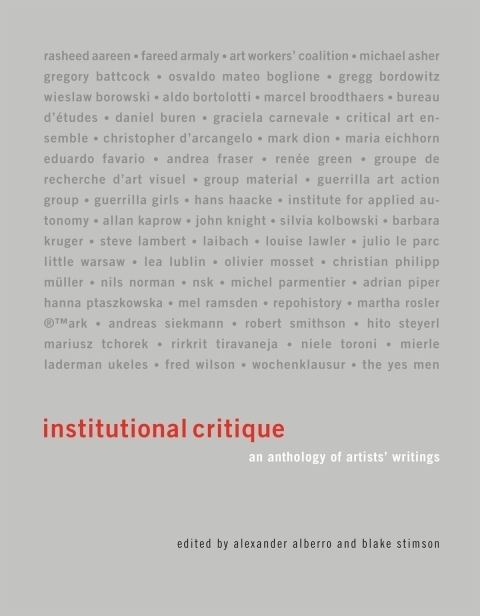 | ||
Art thoughtz institutional critique
In art, Institutional Critique is the systematic inquiry into the workings of art institutions, such as galleries and museums, and is most associated with the work of artists like Michael Asher, Marcel Broodthaers, Daniel Buren, Andrea Fraser, John Knight (artist), Fred Wilson, and Hans Haacke.
Contents
- Art thoughtz institutional critique
- The museum divide beyond institutional critique
- Origin
- Artists
- Criticisms
- References
Institutional Critique is a form of commentary on the various institutions and conventions of art, as well as a radical disarticulation of the institution of art. For instance, assumptions about the supposed aesthetic autonomy or neutrality of painting and sculpture are often explored as a subject in the field of art, and are then historically and socially mapped out (e.g. ethnographically, archaeologically) as discursive formations, then (re)framed within the context of the museum itself. As such, Institutional Critique seeks to make visible the historically and socially constructed boundaries between inside and outside, public and private. Institutional Critique is often critical of the false separations often made between distinctions of taste and supposedly disinterested aesthetic judgement, and affirms that taste is an institutionally cultivated sensibility that may tend to differ according to the class, ethnic, sexual and gender backgrounds of art's audiences.
The museum divide beyond institutional critique
Origin
Institutional Critique is a practice that emerged from the developments of Minimalism and its concerns with the phenomenology of the viewer, as well as formalist art criticism and art history (e.g. Clement Greenberg and Michael Fried), conceptual art and its concerns with language, processes, and administrative society, and appropriation art and its concerns with consumption and identity. Institutional critique is often site-specific, and perhaps could be linked to the advent of the "earthwork" by minimalist artists such as Robert Smithson and Walter De Maria. Institutional critique is also often associated with the developments of structuralist and post-structuralist philosophy, critical theory and literary theory.
Artists
Artists associated with Institutional Critique and active since the 1960s include Marcel Broodthaers, Daniel Buren, Hans Haacke, Michael Asher, John Knight (artist), Christopher D'Arcangelo, Robert Smithson, Dan Graham, Mierle Laderman Ukeles and Martha Rosler. Artists active since the 1980s include Louise Lawler, Antoni Muntadas, Fred Wilson, Renée Green, Andrea Fraser, Christian Philipp Müller, Aaron Flint Jamison, and Mark Dion. More recently, Matthieu Laurette, Graham Harwood, Carey Young, Tameka Norris and others have all taken a critical eye to the modern art museum and its role as a public and private institution. The Artout project, started in 2006 by Anton Koslov Mayr, critically investigates the relationship between artists and collectors.
Haacke's exhibition at the Wallraf-Richartz Museum in Cologne was cancelled due to the inclusion by Haacke of the work "Manet '74" that connected the funding of the museum to the cultural politics of the Cold War. In 1993 Haacke shared, with Nam June Paik, the Golden Lion for the German Pavilion at the Venice Biennale. Haacke's installation "Germania" made explicit reference to the Biennale's roots in the politics of Fascist Italy.
Criticisms
One of the criticisms of Institutional Critique is its complexity. As many have noted, it is a practice that often only advanced artists, theorists, historians, and critics can participate in. Due to its highly sophisticated understanding of modern art and society, as part of a privileged discourse like that of any other specialized form of knowledge, it can often leave layman viewers alienated and/or marginalized.
Another criticism is that it can be a misnomer, since it could be argued that institutional critique artists often work within the context of the very same institutions. Most institutional critique art, for instance, is displayed in museums and galleries, despite its critical stance towards them.
